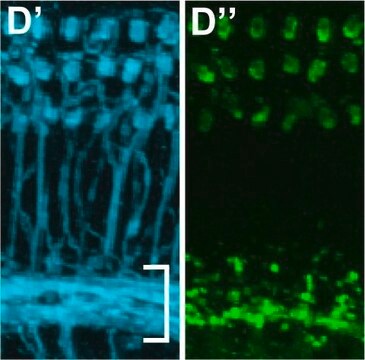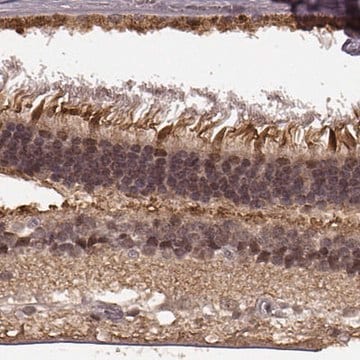일반 설명
We are committed to bringing you greener alternative products, which adhere to one or more of The 12 Principles of Green Chemistry.This antibody is Preservative-free, produced without the harm or sacrifice of animals and exceptionally stable to allow for ambient shipping and storage if needed and thus aligns with "Waste Prevention", "Designing Safer Chemicals" and "Design for Energy Efficiency".
Click here for more information.
ZooMAb® antibodies represent an entirely new generation of recombinant monoclonal antibodies.Each ZooMAb® antibody is manufactured using our proprietary recombinant expression system, purified to homogeneity, and precisely dispensed to produce robust and highly reproducible lot-to-lot consistency. Only top-performing clones are released for use by researchers. Each antibody is validated for high specificity and affinity across multiple applications, including its most commonly used application. ZooMAb® antibodies are reliably available and ready to ship when you need them.
특이성
Clone 3O19-H1 is a ZooMAb® Rabbit recombinant monoclonal antibody that specifically detects -Dystroglycan. It targets an epitope within 20 amino acids from the C-terminal half.
면역원
KLH-conjugated linear peptide corresponding to 20 amino acids from the C-terminal half of human -Dystroglycan.
애플리케이션
Quality Control Testing
Evaluated by Western Blotting in L6 cell lysate.
Western Blotting Analysis (WB): A 1:1,000 dilution of this antibody detected -Dystroglycan in L6 cell lysate.
Tested applications
Immunocytochemistry Analysis: A 1:100 dilution from a representative lot detected -Dystroglycan in HeLa, A431, HUVEC, and NIH3T3 cells.
Affinity Binding Assay:: A representative lot of this antibody bound -Dystroglycan with a KD of 4.4 x 10-8 in an affinity binding assay.
Immunohistochemistry (Paraffin) Analysis: A 1:100 dilution from a representative lot detected -Dystroglycan in human skeletal muscle tissue sections.
Note: Actual optimal working dilutions must be determined by end user as specimens, and experimental conditions may vary with the end user
표적 설명
Dystroglycan (UniProt: Q14118; also known as Dystrophin-associated glycoprotein 1) is encoded by the DAG1 gene (Gene ID: 1605) in human. The dystroglycan complex is involved in a number of processes including laminin and basement membrane assembly, sarcolemmal stability, cell survival, peripheral nerve myelination, nodal structure, cell migration, and epithelial polarization. It also serves as an adhesion molecule and links the extracellular matrix to the intracellular actin cytoskeleton. Its expression is reported in a variety of fetal and adult tissues. It is synthesized with a signal peptide (aa 1-29) that is subsequently cleaved off to generate the mature protein that is further autolytically cleaved (between 653-654) to produce -dystroglycan (aa 30-653) and b-dystroglycan (aa 654-895). -dystroglycan is an extracellular peripheral glycoprotein that binds to several extracellular matrix and synaptic proteins such as laminin-2 and 5, agrin, neurexin, and pikachurin. It is heavily O-glycosylated, which comprises of up to two thirds of its mass and the carbohydrate composition differs depending on tissue type. It is reported that its O-mannosyl glycosylation is required for its ligand- binding functions. b-dystroglycan is a single-pass type 1 transmembrane protein that plays important roles in connecting the extracellular matrix to the cytoskeleton and serves as a cell adhesion receptor in both muscle and non-muscle tissues. In the cell, b-dystroglycan binds to dystrophin that is linked to actin cytoskeleton. Hence, /b dystroglycans act as a molecular axis connecting extracellular matrix with the cytoskeleton across the plasma membrane. Defects in O-mannosyl glycan have been linked to various congenital muscular dystrophies caused by aberrant -dystroglycan glycosylation. This ZooMAb® recombinant monoclonal antibody, generated by our propriety technology, offers significantly enhanced specificity, affinity, reproducibility, and stability over conventional monoclonals.
물리적 형태
Purified recombinant rabbit monoclonal antibody IgG, lyophilized in PBS, 5% Trehalose, normal appearance a coarse or translucent resin. The PBS/trehalose components in the ZooMAb formulation can have the appearance of a semi-solid (bead like gel) after lyophilization. This is a normal phenomenon. Please follow the recommended reconstitution procedure in the data sheet to dissolve the semi-solid, bead-like, gel-appearing material. The resulting antibody solution is completely stable and functional as proven by full functional testing. Contains no biocide or preservatives, such as azide, or any animal by-products. Larger pack sizes provided as multiples of 25 μL.
재구성
300 μg/mL after reconstitution at 25 μL per vial. Please refer to guidance on suggested starting dilutions and/or titers per application and sample type.
저장 및 안정성
Recommend storage of lyophilized product at 2-8°C; Before reconstitution, micro-centrifuge vials briefly to spin down material to bottom of the vial; Reconstitute each vial by adding 25 μL of filtered lab grade water or PBS; Reconstituted antibodies can be stored at 2-8°C, or -20°C for long term storage. Avoid repeated freeze-thaws.
법적 정보
ZooMAb is a registered trademark of Merck KGaA, Darmstadt, Germany
면책조항
Unless otherwise stated in our catalog or other company documentation accompanying the product(s), our products are intended for research use only and are not to be used for any other purpose, which includes but is not limited to, unauthorized commercial uses, in vitro diagnostic uses, ex vivo or in vivo therapeutic uses or any type of consumption or application to humans or animals.









